What Mortals We Humans Be?
a contemplation by Don R. Hender
While not quite Shakespeare, the
full dependence upon God may be felt by such events as Tambora and Krakatoa.
What when in the course of our human events, we are so manipulated, pushed
along and altared by those events which we have no control over. A part of
the western movement of the early colonial settlers of the United States of
America was spurred by just such an uncontrolled event.
What diference can a volcanic eruption make? Halfway around the world are
located two such volcanic phenomenon. There resides Tambora and Krakatoa.
You have likely heard of the famous or infamous August 27th 1883
eruption of Krakatoa. That colossal eruption of the volcano at Krakatoa in
in the eastern Pacific Ocean became a worldwide weather and media event.
Sunsets around the world were seen in bizarre 'blood red' colors caused by
the particles in the atmosphere in distant lands such as Great Britain and
the United States.
Krakatoa events were further significant because it was the first time that
detailed descriptions of the colossal event traveled around the world so
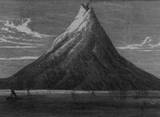 quickly as they were carried by undersea telegraph wires. Krakatoa had a
tall high hat as seen in this Harpers Weekly Laibrary of Congress image
before you could say 'It blew its top clean off'. But actually, 'It blew
itself clean out of the water,' so to speak. Today we vagely recall Mt. St.
Hellens, which did somewhat the same.
quickly as they were carried by undersea telegraph wires. Krakatoa had a
tall high hat as seen in this Harpers Weekly Laibrary of Congress image
before you could say 'It blew its top clean off'. But actually, 'It blew
itself clean out of the water,' so to speak. Today we vagely recall Mt. St.
Hellens, which did somewhat the same.
Krakatoa's height had been lifted up to some 2,600 feet above sea level and
its mountainous slopes were covered with green vegetation. It was quite the
notable landmark to sailors of the Sunda Straits.
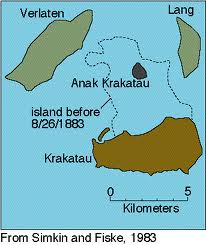 In the years preceding the massive eruption several
earthquakes occured in the area. In June of 1883 small volcanic eruptions
began to to rumble across the island. Throughout the summer the volcanic
activity continued to increase and tides at near islands began to be affected.
Finally on the 27th of August four massive explosive eruptions
occurred. The final gigantic explosion destroyed two-thirds of
the island of Krakatoa blasting it to dust which filled the air. Tsunamis
were created rising higher up to 120 feet which slammed into the coastlines
of the inhabited islands. It is estimated that some 36,000 people were
killed.
In the years preceding the massive eruption several
earthquakes occured in the area. In June of 1883 small volcanic eruptions
began to to rumble across the island. Throughout the summer the volcanic
activity continued to increase and tides at near islands began to be affected.
Finally on the 27th of August four massive explosive eruptions
occurred. The final gigantic explosion destroyed two-thirds of
the island of Krakatoa blasting it to dust which filled the air. Tsunamis
were created rising higher up to 120 feet which slammed into the coastlines
of the inhabited islands. It is estimated that some 36,000 people were
killed.
Less than 70 years prior, in 1815, just such another event had occured. You
may not have ever heard of it. It was called Tambora. Still a part of the
Sunda Island group, Tambora was not in the narrow straits between Java and
Sumatra. But I guess that such once-in-a-lifetime events just are not often
remembered in the 'next' lifetime, having already passed from general mortal
review. And then back in 1815 there was not the immediate newsing of the event
which the oceanic tele-cables offered to the world. Thus it is true that
Krakatoa is Indonesia's most celebrated volcanoes, but did you know that
Krakatoa is just Tambora's 'little sister'.
T A M B O R A
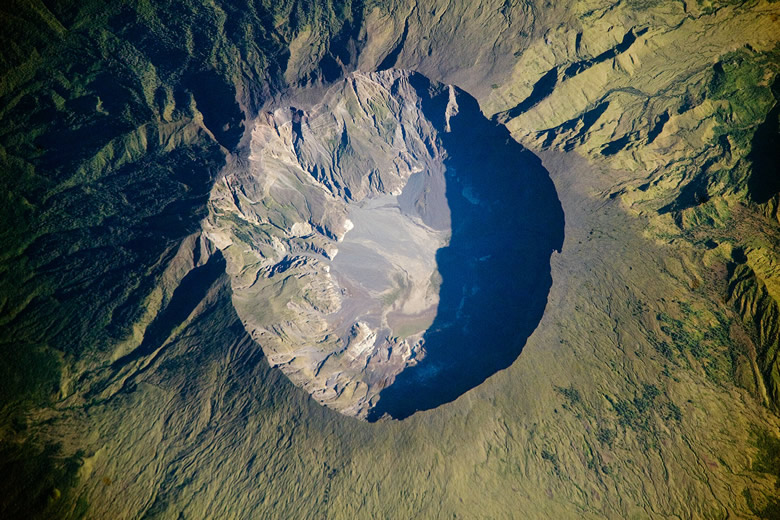 Astronaut photograph of Tambora Volcano's summit
caldera acquired on June 3, 2009. Image credit NASA/Earth Observatory
Astronaut photograph of Tambora Volcano's summit
caldera acquired on June 3, 2009. Image credit NASA/Earth Observatory
|
Largest Eruption in Recorded History
Krakatoa had spend two thirds of herself in her explosive finale in 1883. In
the eruption of Tambora in 1815, she expelled at least four times the ash
into the air as did Krakatoa for all of her efforts. Krakatoa had distupted
shipping through the straits and was well observed and reported timely.
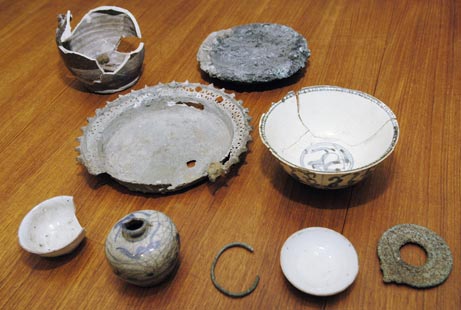 Tambora had no such restricted straits' shipping lanes and was not readily
observed or reported. Krakatoa killed some 36,000 and disrupted shipping.
All Tambora did was kill some estimated 117,000 according to latest estimates
and completely destroy the Kingdom of Tambora.
Tambora had no such restricted straits' shipping lanes and was not readily
observed or reported. Krakatoa killed some 36,000 and disrupted shipping.
All Tambora did was kill some estimated 117,000 according to latest estimates
and completely destroy the Kingdom of Tambora.
In fact the Mount Tambora
Eruption was hardly known at all. Ever hear of the Kingdom of Tambora? Well
its gone now with only such recently excavated ceramic pots, bronze bowls,
iron tools and metal bracelets remaining. And for world effects, Tambora's
was not just 'blood red' sunsets. Tambora world wide ash cover caused gray
clouded overcast days around the world as so reported in Europe and elsewhere.
When Tambora exploded the sound was heard as far away as in India, some 3,000
miles distance. And the world wide ash filled atmosphere caused a global
temperature cooling change and the infamous 1816 'Year Without A Summer' as
hard frost freezes in mid-summer destroyed crops in such seasonal regions as
the New England states of America.
The Year Without Summer
Due to the series of volcanic eruptions or the few years leading up to the
big one, crops in various northern region had been growing poorer for some
years. The final blow came in 1815 with the great eruption of Tambora. Europe
was still recuperating from the Napoleonic Wars, and food shortages. Food
riots broke out in the United Kingdom and France with grain warehouses being
looted. The violence was worst in landlocked Switzerland. There was huge
storms and abnormal rainfall with flooding of the major rivers of Europe
including the Rhine and frost was still setting in during August. A major
typhus epidemic occurred in Ireland between 1816 and 1819 precipitated by the
famine caused by 'The Year Without a Summer'.
Tambora was racking up world
wide indirect and residual deaths such as an estimated 100,000 Irish in
Ireland, twice the average fatality rates in Switzerland and a European
fatality total of 200,000 deaths.
In the New England states of America crop failures was the norm and corn
ripened so badly that less than a quarter of it was usable. These crop failures
in New England, Canada and across Europe caused the price of wheat, grains,
meat, vegetbles, butter, milk, and flour to rise shapely. Hungary experienced
brown snow and Italy red snow falling throughout the year from the volcanic
ash in the air.
The unusually low temperatures in summer in China devastated
rice production in Yunnan province resulting in widespread famine. In many
tropical regions of the Asian east snow was report in such as Hsinchu, Miaoli,
of Taiwan and summer snow fall in the Jiangxi, and Anhui provinces. Frost was
reported in Changhua.
The crop failures of the 'Year without a Summer' helped in the settling of
the 'American Heartland' as many thousands of people, particularly farm
families, left New England for western and central New York, and the Upper
Midwest (then the Northwest Teritory) as they were searching for more
hospitable climates, richer soil and better growing conditions.
According to historian L. D. Stillwell, Vermont alone experienced a drop of
10,000 to 15,000 people, erasing seven years of population growth. Among those
families who left Vermont was the family of Joseph Smith, who moved from
Sharon, Vermont to Palmyra, New York. This move 'precipitated' or
'facilitated' the series of events which culminated with the publication of
the Book of Mormon and the founding of the Church of Jesus Christ of
Latter-day Saints.
With every rain cloud, or I suppose volcano, there is a silver lining. What would
have happened if Joseph Smith's family had not so removed to where the golden
plates had been laid hidden?
So What Now?
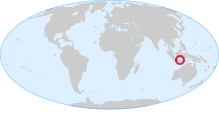 What about Krakatoa and Tambora today? Well they are both again increasing
in activity. Krakatoa is building herself a little child, 'Anak Krakatau'.
And as late as September, 2011, Tambora had been placed on the second highest
watch level as her ever increasing activity is again rolling in. Will these
two sister volcanos play a roll in coming years events leading up to the
Second Coming. Certainly they have both proven to be world wide contenders
to play such contributing roles in those last days events.
What about Krakatoa and Tambora today? Well they are both again increasing
in activity. Krakatoa is building herself a little child, 'Anak Krakatau'.
And as late as September, 2011, Tambora had been placed on the second highest
watch level as her ever increasing activity is again rolling in. Will these
two sister volcanos play a roll in coming years events leading up to the
Second Coming. Certainly they have both proven to be world wide contenders
to play such contributing roles in those last days events.
What is in store
for us in the course of human events? These things are but in the hands of
the Lord and we but humans be.
One Suggested Ash Cloud Estamate of Tambora Per Populated Areas Reporting
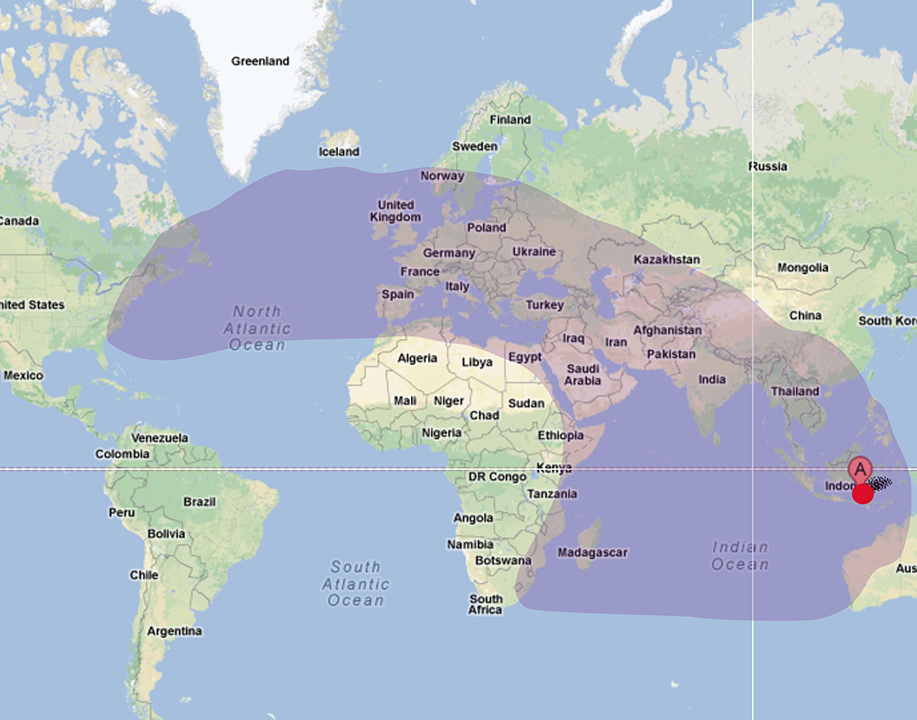 Yellowstone is many times larger than Tambora, and the world is far more populated today.
Yellowstone is many times larger than Tambora, and the world is far more populated today.
ver. 4 Febuary 2016
 quickly as they were carried by undersea telegraph wires. Krakatoa had a
tall high hat as seen in this Harpers Weekly Laibrary of Congress image
before you could say 'It blew its top clean off'. But actually, 'It blew
itself clean out of the water,' so to speak. Today we vagely recall Mt. St.
Hellens, which did somewhat the same.
quickly as they were carried by undersea telegraph wires. Krakatoa had a
tall high hat as seen in this Harpers Weekly Laibrary of Congress image
before you could say 'It blew its top clean off'. But actually, 'It blew
itself clean out of the water,' so to speak. Today we vagely recall Mt. St.
Hellens, which did somewhat the same.
 In the years preceding the massive eruption several
earthquakes occured in the area. In June of 1883 small volcanic eruptions
began to to rumble across the island. Throughout the summer the volcanic
activity continued to increase and tides at near islands began to be affected.
Finally on the 27th of August four massive explosive eruptions
occurred. The final gigantic explosion destroyed two-thirds of
the island of Krakatoa blasting it to dust which filled the air. Tsunamis
were created rising higher up to 120 feet which slammed into the coastlines
of the inhabited islands. It is estimated that some 36,000 people were
killed.
In the years preceding the massive eruption several
earthquakes occured in the area. In June of 1883 small volcanic eruptions
began to to rumble across the island. Throughout the summer the volcanic
activity continued to increase and tides at near islands began to be affected.
Finally on the 27th of August four massive explosive eruptions
occurred. The final gigantic explosion destroyed two-thirds of
the island of Krakatoa blasting it to dust which filled the air. Tsunamis
were created rising higher up to 120 feet which slammed into the coastlines
of the inhabited islands. It is estimated that some 36,000 people were
killed.

 Tambora had no such restricted straits' shipping lanes and was not readily
observed or reported. Krakatoa killed some 36,000 and disrupted shipping.
All Tambora did was kill some estimated 117,000 according to latest estimates
and completely destroy the Kingdom of Tambora.
Tambora had no such restricted straits' shipping lanes and was not readily
observed or reported. Krakatoa killed some 36,000 and disrupted shipping.
All Tambora did was kill some estimated 117,000 according to latest estimates
and completely destroy the Kingdom of Tambora.
 What about Krakatoa and Tambora today? Well they are both again increasing
in activity. Krakatoa is building herself a little child, 'Anak Krakatau'.
And as late as September, 2011, Tambora had been placed on the second highest
watch level as her ever increasing activity is again rolling in. Will these
two sister volcanos play a roll in coming years events leading up to the
Second Coming. Certainly they have both proven to be world wide contenders
to play such contributing roles in those last days events.
What about Krakatoa and Tambora today? Well they are both again increasing
in activity. Krakatoa is building herself a little child, 'Anak Krakatau'.
And as late as September, 2011, Tambora had been placed on the second highest
watch level as her ever increasing activity is again rolling in. Will these
two sister volcanos play a roll in coming years events leading up to the
Second Coming. Certainly they have both proven to be world wide contenders
to play such contributing roles in those last days events.
